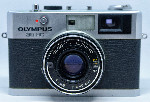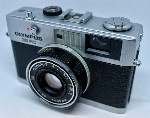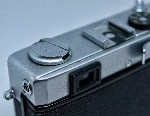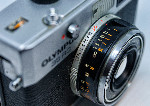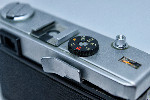This unassuming, tiny camera really packs a punch!
Olympic
Olympus 35RC
Camera: £6.10
Postage: £4.00
Total: £10.10
It’s one of the smallest rangefinder cameras around and pretty light considering it’s mostly metal. It came out in 1970 at around £50, which would be over £700 in today’s money – cameras were expensive things. Luckily for me they made a lot of them and I got this one for a tenner. There are quite a few good reviews around which makes prices fluctuate a little, but there are plenty out there so you can be patient and wait for a bargain. Note that mine is missing the self-timer lever which was perhaps snapped off on purpose as trying to operate the timer seems to cause a few temporary glitches. Buying it was a bit of a gamble, as it was listed as:
“spares and repairs
has damage
lens cap is present
untested
no idea if can be fixed or if works
see pictures for condition”
I’m no expert at repair, I just use my IT Support skills of working the controls back and forth in the hope that something happens and I got lucky with this camera. As it turned out the camera was fine, but switched to auto with a dead battery, so refused to do anything and appeared broken, a new LR9 battery (hearing-aid button-type, £3.89 for 10) fixed it right up. Good similar-priced alternatives depending on on-the-day prices would be a Yashica Lynx or Minister, Konica S or C35, Canon Canonet 28, Ricoh 500G, or a Petri Color 35. Possible ones to avoid are Canon Canonet 19 – overpriced, Rollei 35 – probably broken and Yashica Electro 35 – needs special battery.
A Good Starter Camera
If you’re looking for somewhere to start film photography, you could do a lot worse than this camera. You can set the film speed in 1/3rd increments from 25 to 800 – which is almost every film you’re likely to want to use, including some you probably shouldn’t. Focusing the rangefinder takes a little getting used to – see the Zorki 6 post – but it’s better than guessing, although you’re mostly fine using the numbers on the dial as estimates for taking quick shots. On bright days you can use the Sunny 16 rule which is where you pre-set the aperture to f16, and the shutter to about 1/ISO of the film and you can snap away all day at anything between 2.5 metres and the horizon without having to precisely focus.
The auto setting shows you inside the viewfinder what aperture is going to be used as you half-press the shutter and it goes into the red zone and won’t let you take a picture if it’s too dark or too light. You can then adjust the shutter speed to try and get your desired aperture or set it manually using what the meter in the viewfinder told you as a guide. You can even do the half-press without winding the film on so you don’t run the risk of taking a picture by mistake if you are a clumsy oaf like me. If that half-press sounds familiar it’s because even modern cameras have copied the idea. Then, after making sure you have wound it on just hold it still and upright and press the shutter for a slighty-disappointingly quiet click, here’s what happened when I did that:
Off to the Movies
Fuji Eterna 500T
Cost: £2.50
Postage: £0.58
Expired: New film
ISO: 500
Format/Type: Remjet-backed colour negative
Exposures: ~33
Processing: £2.95
Full Total: £6.03
Cost per shot: £0.18
My Rating: 8
Movie cameras get through a lot of film so have to have strong insides, unfortunately the strongest metals are often the shiniest, which is rubbish for photography, so motion picture films have an anti-halation or RemJet backing layer designed to block reflections from inside the gubbins.
This has to be washed off before processing by soaking it in a hot solution of potassium bicarbonate and [nitrilotris(methylene)]tris-phosphonic acid pentasodium salt – I mean I’m no Chemist but I’m guessing that’s where the splotches come from – it sounds super-splotchy, right?
Then it is recommended to use RA-4 chemistry for the development stage, which is normally what you use for developing prints on paper like I never do, so I didn’t have any of that and just used regular C-41 colour developer instead. That would be why the colours aren’t quite right.
Regardless I’m more than happy with the results – the unusual colour gives it a bit of atmosphere and I didn’t want to correct it away, the splotches too remind you that film photography is an organic process. Also they are some pretty nice shots and I like them.
This camera is definately coming out to play again sometime soon, it also works great with a flash and produces nice portraits.

